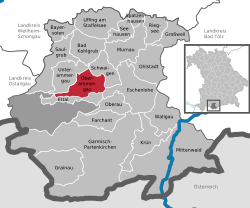Oberammergau | |
|---|---|
 Oberammergau from the summit of Kofel | |
Location of Oberammergau within Garmisch-Partenkirchen district  | |
| Coordinates: 47°35′48″N11°03′52″E / 47.59667°N 11.06444°E | |
| Country | Germany |
| State | Bavaria |
| Admin. region | Oberbayern |
| District | Garmisch-Partenkirchen |
| Government | |
| • Mayor (2020–26) | Andreas Rödl [1] (CSU) |
| • Governing parties | CSU |
| Area | |
• Total | 30.06 km2 (11.61 sq mi) |
| Elevation | 837 m (2,746 ft) |
| Population (2023-12-31) [2] | |
• Total | 5,335 |
| • Density | 177.5/km2 (459.7/sq mi) |
| Time zone | UTC+01:00 (CET) |
| • Summer (DST) | UTC+02:00 (CEST) |
| Postal codes | 82487 |
| Dialling codes | 08822 |
| Vehicle registration | GAP |
| Website | www.gemeinde-oberammergau.de |
Oberammergau is a municipality in the district of Garmisch-Partenkirchen, in Bavaria, Germany. The small town on the Ammer River is known for its woodcarvers and woodcarvings, for its NATO School, and around the world for its tradition of mounting decennial Passion Plays since 1633.





















